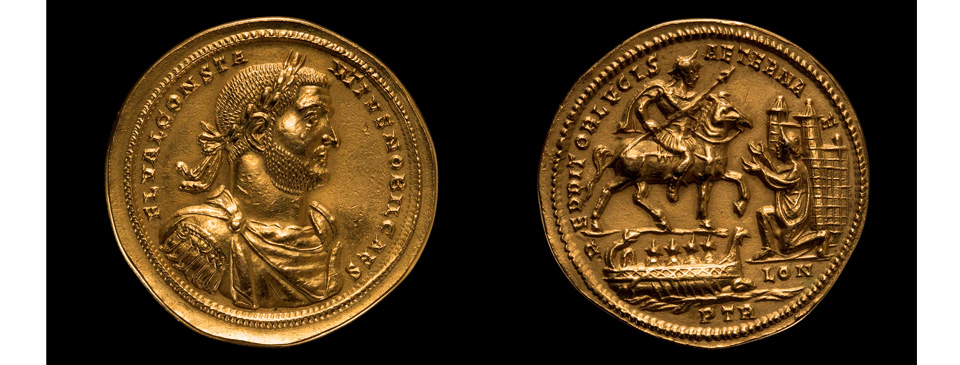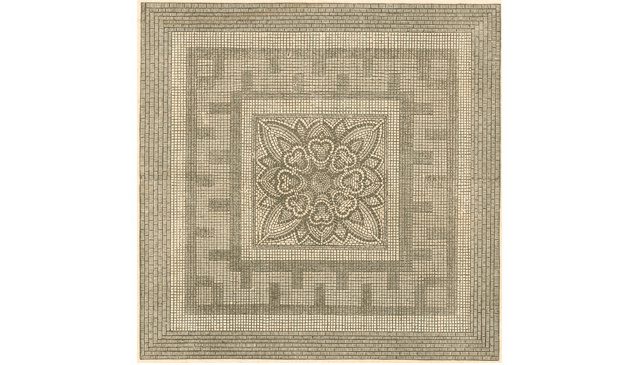The decline of Londinium

During the Roman period coins were one of the main means of spreading propaganda or celebrating major victories. On one side of this gold coin, minted in Trier, is the head of Constantius. The reverse side shows him arriving at Londinium on horseback, together with a ship of his navy. A grateful woman, outside the city wall and with the letters “LON” below her, represents the spirit of Londinium. She is thanking him for saving the town from being destroyed by Frankish barbarians. The coin is inscribed “REDDITOR LUCIS AETERNAE” (Restorer of Eternal Light). Although simplistic, this is the earliest-known visual depiction of London.
Londinium was established relatively late in the history of the Roman Empire. It continued to prosper while other parts of the empire came under attack and went into decline. As the more northerly Continental provinces were overrun by barbarians Londinium was unable to survive alone.
Roman civilisation reached its zenith during the mid-1st century, at around the same time that London was being established. While London matured and grew on the western extreme of the empire through the 2nd and 3rd centuries it was protected, and occasionally prospered, from troubles in Rome and elsewhere.
In the latter 2nd century a smallpox plague spread across the empire, killing between 10 and 25 percent of the population. With garrison towns decimated, the empire’s borders became vulnerable and barbarians invaded from the Germanic north. Greater resources required to provide military security necessitated higher taxes, which caused resentment. Divisions grew between the eastern Greek-speaking and Latin-speaking western provinces of the empire. There was much in-fighting and rebellion during the first half of the 3rd century. In 260 the empire was over-run by Alamanni, Franks and Goths from the north, Moors from the south and Persians from the east. Only Rome, the Italian peninsular and Britannia remained untouched. The Romans fought back but large areas of the empire were lost forever.
Britannia was not entirely immune from attack. The Franks, based in the lower Rhineland areas, began making raids on the wealthy and vulnerable east of Britannia and the Thames estuary. Inland agricultural areas prospered, and large mansions were built or expanded, but people of wealth abandoned the areas around the coasts of East Anglia, the Thames Estuary, Kent, the south, and Severn Estuary where they were vulnerable from raids by the Franks or Irish. Long-distance shipping in and out of Londinium was unlikely to have been affected but coastal shipping was probably in greater danger. In the early 3rd century, about 150 years after their arrival, the Romans replaced Londinium’s defensive mound with a wall over three kilometres long, six and a half metres high and enclosing an area of 326 acres.
Londinium expanded rapidly during the 1st and 2nd centuries when traders and financiers arrived to exploit the expanding new market of the province of Britannia. In the 120s Emperor Hadrian decreed that the borders of the empire should be fixed. Within the British Isles a wall was built across the province’s northern boundary and the empire never expanded to incorporate Scotland or Ireland. Without the momentum of expansion, and being a dead-end on the far western edge of civilised Europe, new merchants were thereafter less likely to come to Londinium. Instead they looked eastwards where there were distant markets with which to trade. The growth-rate of Londinium had slowed by the 3rd century and a long, slow decline began.
Trade was not the only factor in the stagnation and decline of Londinium. Although there is no documented evidence, the empire’s plague of the 170s must have reached Londinium due to the constant ships arriving at the port. The town’s population level fell at the end of 2nd century. By the beginning of the following century parts of the town that had previously been built on were being covered over for market gardening. The public bathhouse at Upper Thames Street was demolished, probably because it was no longer viable to keep it continually heated. There was clearly a serious and immediate threat in the late 3rd century because the defensive wall, which had until then encircled only the landward sides, was hastily extended along the riverside.
In or around 286 Marcus Carausius, the admiral in charge of the Channel Fleet, rebelled, seizing Britannia and parts of Gaul and isolating them from Rome for the next decade. Without official Roman coinage a mint was established in Londinium, with a number of the rebel coins being found on a ship that was sunk around that time in the area of what is now County Hall. The Londinium mint continued in operation until the early 4th century.
Augustus Maximian, head of the western part of the empire, appointed his deputy, Constantius, to organise a campaign of recovery of the provinces. In 293 he re-took the port of Boulogne, followed by the other parts of Gaul. As Constantius waited to re-take Britannia, Carausius was murdered by his finance minister Allectus, taking advantage of the political uncertainty, and declaring himself the new Emperor of Britannia. Finally, in 297 Constantius assembled two fleets of ships, one of which landed at Southampton and the other, sailing from the Rhine under his direct command, headed for Londinium. Allectus had enlisted large numbers of Franks but they were more interested in looting Londinium than in fighting. As the citizens of Londinium feared the destruction of the town at the hands of the Franks, Constantius’s ships arrived. The citizens watched from the city walls as the Roman forces slaughtered the barbarians. Constantius celebrated victory by minting gold coins depicting him arriving on horseback at Londinium’s walls to be greeted by one its inhabitants, accompanied by a ship of his fleet. The accompanying legend states in Latin “Restorer of Eternal Light”. Although only a simplified illustration, it is the oldest-surviving image of London.
Londinium had been saved from the barbarian looters but then faced the wrath of the emperor for their support of the rebels. The magnificent basilica and forum were destroyed. Britannia was divided into four provinces, with Londinium as capital of only one quarter of the province, most likely as punishment.
As towns and rural areas in the western Continental part of the empire came under threat and were increasingly abandoned, Britannia became ever more important for the supply of goods and foodstuffs. When the thick forests of northern Europe were lost to the barbarians Britannia’s timber became a new export, easily transportable by water from Londinium. The great oak forest around Middlesex began to be thinned during the 4th century.
In 367 Britannia was invaded by an alliance of Picts, Irish, Franks and Saxons. Forces under the command of the Spanish Count Theodosius were sent by the Emperor Valentinian to restore order. He quickly recovered Londinium where he spent the winter months before regaining the rest of the country during the following Spring. New defences were added to Londinium’s wall in the form of bastions that held catapults.
In the 380s a Spanish Roman general in Britannia rebelled and declared independence from the empire. He led the army in Britannia to the Continent, where he took Gaul, Spain and much of Italy before his defeat in 388. The Roman army was never to return in force, although the provinces needed further temporary defence when the Irish, Picts and Saxons invaded once again at the very end of the 4th century.
Londinium went into a long, slow decline during the 4th century. It had become successful partly because it was the most convenient port from which to trade with the Rhineland and near Continent. As the Roman armies lost control of the northern Continental areas, and it became safer to ship goods to and from Boulogne, the ports on the south coast of Britannia became more convenient. By the end of the 4th century Winchester had overtaken London as Britannia’s leading commercial centre.
During the 4th and 5th centuries sea levels throughout Europe rose, causing problems in all low-lying coastal areas. Londinium and the lower Lea valley became prone to flooding from time to time and Ermine Street, the main road leading directly north out of the town, occasionally became impassable.
Britannia was by then no longer governed directly from Rome and much of the government administration was either dealt with from Trier or devolved to capitals of the smaller provinces into which Britannia had been divided. The town’s population gradually dwindled, concentrated along the riverside. Many buildings were no longer occupied and earth was laid over derelict structures so that the land could be used for farming. Even into the Middle Ages half of the land within the city walls was still being farmed as fields, orchards and gardens.
Barbarian attacks were becoming more threatening to Britannia and the population appealed to the Emperor Honorius for help. But Rome itself was under immediate threat from the Visigoths, who briefly entered the city in 410, carrying away much of its valuable possessions. After the Visigoths had already left Rome Honorius replied to the British that he was unable to help them at that moment and authorised them to take care of their own defences. No doubt he was optimistically expecting to send troops at a later time but in reality Britannia was no longer a province of the great empire to which it had been part for three and a half centuries.
Roman Londinium continued to be occupied but its population gradually dwindled until it gradually decayed and was eventually abandoned. In about 429 Germanus, Bishop of Auxerre, visited the town and reported that life continued as normal. During the early part of the century tiles were still being produced and therefore houses maintained to some extent. At least one house was occupied in 440 and still receiving supplies from the Mediterranean. Yet by the end of that century Londinium seems to have been deserted, and remained so for over 400 years until re-established by the Saxon King Alfred of Wessex.
Sources include: John Morris ‘Londinium – London in the Roman Empire’; Simon Webb ‘Life in Roman London’; Dominic Perring ‘Roman London’; Gustav Milne ‘The Port of Roman London’; Peter Marsden ‘Ships of the Port of London, First to eleventh centuries AD’
< Back to Roman London


